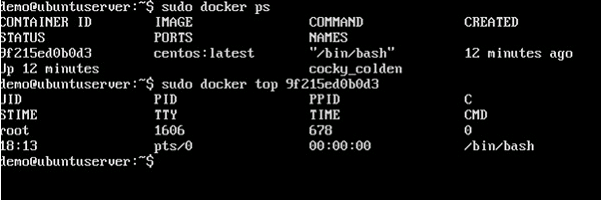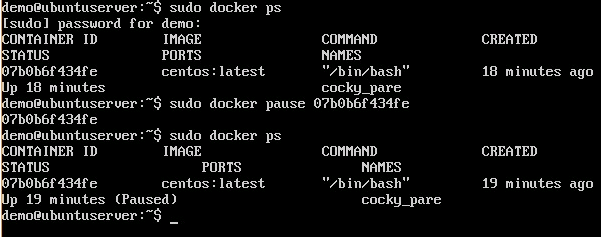Docker Container
Docker Container is a running instance of a Docker Image or Containers are the ready applications created from Docker Images and they hold the entire package needed to run the application. This happens to be a definitive utility of Docker. Want to read more about Docker Hub?
The business standard today is to utilize Virtual Machines (VMs) to run programming applications. VMs run applications inside a guest Operating System, which keeps running on virtual hardware powered by the server’s host Operating System.
VMs are incredible at giving full procedure separation to applications: there are not many ways an issue in the host operating system can influence the software running in the guest operating system, and the other way around. Be that as it may, this isolation comes at an incredible expense — the computational overhead spent virtualizing hardware for a guest OS to utilize is generous.
Containers adopt an alternate strategy: by utilizing the low-level mechanics of the host operating system, containers give the greater part of the isolation of virtual machines at a small amount of the computing power. Want to read more about Docker Documentation?
Why use containers?
Compartments offer a logical packaging mechanism in which applications can be preoccupied from the environment in which they really run. This decoupling permits container-based applications to be conveyed effectively and reliably, paying little respect to whether the target environment is a private data center, the open cloud, or even a developer’s personal laptop. This enables designers to make unsurprising situations that are detached from the rest of the applications and can be run anyplace.
From a task point of view, aside from portability containers likewise give progressively granular authority over resources giving your foundation improved proficiency which can bring about better use of your compute resources. Want to read more about Docker Compose?
Running a Container
Docker run command manages running of containers. First launch the Docker container, to run a container in an interactive mode.
sudo docker run –it centos /bin/bash
you will return to your OS shell by hitting Crtl+p.

You will at that point be running in the instance of the CentOS system on the Ubuntu server.
Docker – Working with Containers
docker top
you can see the top processes within a container with this command.
Syntax:
docker top ContainerID
Options:
ContainerID − This is the ID of the Container for which you want to see the top processes.
Return Value:
Its output will show the top-level processes within a container.
Example:
sudo docker top 9f215ed0b0d3
This command will show you the top-level processes within a container.
Output:
On running the above command, it will produce the following result –

docker stop
Syntax:
docker stop ContainerID
Options:
- ContainerID− This is the ID of the Container which needs to be stopped.
Return Value:
The output will give the ID of the container that is stopped.
Example:
sudo docker stop 9f215ed0b0d3
This command will stop the Docker container 9f215ed0b0d3.
Output:
On running the above command, it will produce the following result –

docker rm
This command is used to delete or remove a container.
Syntax:
docker rm ContainerID
Options:
- ContainerID− This is the ID of the Container which needs to be removed.
Return Value:
The output will give you the ID of the removed container.
Example:
sudo docker rm 9f215ed0b0d3
This command will remove the Docker container 9f215ed0b0d3.
Output:
On running the above command, it will produce the following result –

docker stats
This command is used to provide the statistics of the container that is running.
Syntax:
docker stats ContainerID
Options:
- ContainerID− This is the ID of the Container for which the stats need to be provided.
Return Value:
The output will show the CPU and Memory utilization of the Container as statistics.
Example:
sudo docker stats 9f215ed0b0d3
This command will provide CPU and memory utilization of the Container 9f215ed0b0d3.
Output:
On running the above command, it will produce the following result –

docker attach
This command is used to attach to a container that is running.
Syntax:
docker attach ContainerID
Options:
- ContainerID− This is the ID of the Container to which you need to attach.
Return Value:
None
Example:
sudo docker attach 07b0b6f434fe
This command will attach to the Docker container 07b0b6f434fe.
Output:
On running the above command, it will produce the following result –

After attachment to the Docker container, you can run the above command to see the process utilization in that Docker container.

docker pause
This command is used to pause or stop the processes in a running container.
Syntax:
docker pause ContainerID
Options:
- ContainerID− This is the ID of the Container to which you need to pause the processes in the container.
Return Value:
The ID of the paused container.
Example:
sudo docker pause 07b0b6f434fe
This command will pause the processes in a running container 07b0b6f434fe.
Output:
On running the above command, it will produce the following result −

docker unpause
This command is used to unpause or resume the processes in a running container.
Syntax:
docker unpause ContainerID
Options:
- ContainerID− This is the ID of the Container to which you need to unpause the processes in the container.
Return Value:
The ID of the running container.
Example:
sudo docker unpause 07b0b6f434fe
This command will unpause the processes in a running container: 07b0b6f434fe
Output:
On running the above command, it will produce the following result −

docker kill
This command is used to kill or close the processes in a running container.
Syntax:
docker kill ContainerID
Options:
- ContainerID− This is the ID of the Container to which you need to kill the processes in the container.
Return Value:
The ID of the running container.
Example:
sudo docker kill 07b0b6f434fe
This command will kill the processes in the running container 07b0b6f434fe.
Output:
On running the above command, it will produce the following result –

Docker – Container Lifecycle
The figure and illustrations below explain the entire lifecycle of a Docker container.

- At the initial point, the Docker container will be in the created
- Then the container goes into the running state when the Docker run command is used.
- The Docker kill command is used to kill an existing container.
- The Docker pause command is used to pause an existing container.
- The Docker stop command is used to pause an existing container.
- The Docker run command is used to put a Docker container back from a stopped state to a running

